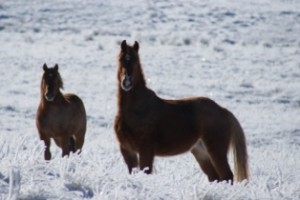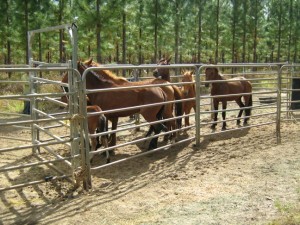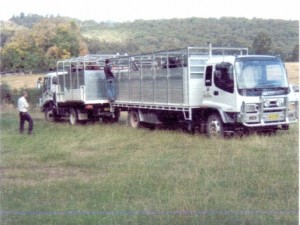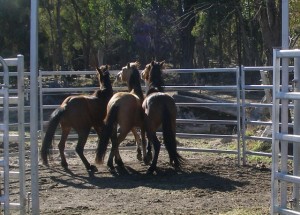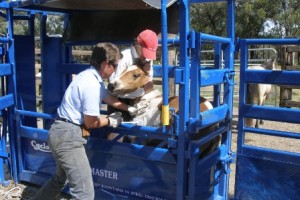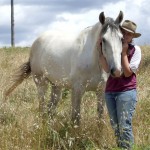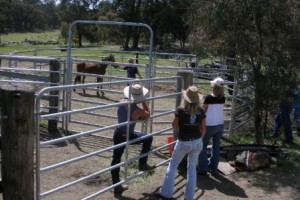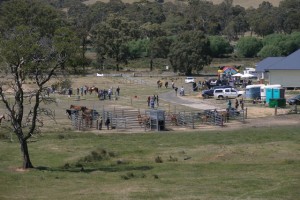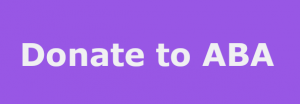This article describes the whole re-homing process for re-homing groups registered with relevant National Park authorities, providing guidance from those wishing to start up their own groups.
If you would like to adopt or sponsor a Brumby from an ABA member organisation, follow the links below:
ABA has produced a comprehensive guide for people who adopt and rehome a Brumby horse:
If you would like to become an approved rehoming group or individual, you should also visit:
Understanding the full Brumby re-homing process
National Park authorities regularly cull significant numbers of Brumbies because of the perceived damage Brumbies do to the environment. While the ABA agrees that too many Brumbies (as with any overabundant species, including humans) can be a problem, our position is that moderate Brumby populations in fact provide positive impacts to their environment [see our ABA Papers page]
Park authorities in Queensland, WA, NT and SA regularly use aerial shooting to cull Brumby numbers. In NSW and Victoria, ABA member groups have lobbied authorities to use the most calm and humane method of passive trapping to cull Brumbies under each National Park management plan [see our Passive Trapping page].
Unless rehoming groups or skilled individuals offer to drive up, collect, look after, gentle and re-home as many as they can safely take at their own expense, all Brumbies removed by National Park authorities under their management plans are sent to abattoirs. National Park authorities do not provide any funding to assist re-homer costs, time and skills.
Rehoming groups struggle to cover transport, gelding, feed, and other vet bills when selling on gentled Brumbies. Adoption fees never cover infrastructure, land holding areas and their volunteered time, so re-homers depend on donations, in addition to adoption fees, to continue their work. For every Brumby gentled and sold on, a charity can then collect another Brumby that would otherwise end at the abattoir.
Contents
Establishing a Re-Homing Group
Introduction
In simple terms, Re-Homing is the process of relocating brumby horses from a wild situation, be it a government conservation area or a station property and settling them into a domestic environment. But nothing is quite that simple and to successfully and humanely take a brumby from the wild and take it to the point of ownership involves a number of steps.
For more than a century, horsemen have been capturing wild horses for their own use, typically (but not always) on horseback by chasing and roping horses (Brumby Running). For the purpose of this discussion, however, we will be describing the types of activities and issues for recognized Re-Homing groups such as member groups of ABA.
Establishing a Re-Homing Group
Many groups start with one or two individuals who hear about a cull or inhumane treatment to brumbies and want to do something. Some have adopted a brumby and learn more about their plighand training wild or green broke horses, let alone setting up a Re-Homing group. Initially there may only be a few core people involved.
The first phase is generally investigation – contacting ABA or ABA Member groups. If there is not a Re-Homing group near them that they can offer help, it is then that the idea to start another group tends to emerge.
Assistance from existing Re-Homing groups is important for information, support and to help speed up the process. ABA Members must be incorporated not-for profit bodies, preferably with charity status. Help with this process, including developing a Constitution and relevant documents and paperwork is one example of how ABA can help.
A number of administrative and operational issues need to be sorted and developed and each Re-Homing group needs to tailor these to their resources, environment and the type of horse populations they plan to re-home.
Working with Authorities
All ABA Re-Homing groups have some form of agreement with government authorities in regard to taking horses and offering a Re-Homing program. Negotiation often takes months and the Re-Homing group will have to demonstrate its ability to carry out the job. Usually RSPCA approval is also obtained. This forms the basis for the ongoing relationship with government authorities and ground staff and may lead to the Re-Homing group having a representative on some form of management or steering committee.
Capture
Capture is not responsibility of the Re-Homing groups although occasionally groups may assist government staff. Not all capture methods are what ABA considers humane and we are working to change this. Current practices used in government capture programs vary from humane passive trapping, mustering on horseback, motorbike or helicopter into a trap area or by brumby running (roping from horseback).
Captured horses are kept in yards, or sometimes tied to trees (see Brumby Running) until sufficient numbers are caught for transport out of the area.
ABA stongly advocates for humane passive trapping methods.
In passive trapping programs, horses are usually assessed if fit for transport and identification information is recorded.
To determine an appropriate capture method, we recommend you take the following measures:
- Establish your options – helicopter/ground mustering, passive trapping, lure horses with food or water, how?
- Passive trapping is preferred as stress/negative human experience is minimised.
- Identify who will do the trapping; Parks, separate contractor or your group.
- Get as much information as possible on the various techniques and how to undertake them. Contact experienced groups. For example, if you muster, stallions cannot be run as far as mares, and mares and foals can only be run for a certain distance before they MUST be rested or they will die.
Transport
It is generally at the Re-Homing group’s expense that horses are transported from the removal area. Some groups use their own horse trucks or floats and in the case of the OHHAWA travel great distances to take horses. Other groups, may engage a horse transport contractor with the ability to access remote areas to transport horses.
Although most Re-Homing groups have at least one horse float or trailer among their membership, these are difficult to use with a wild horse that has not been float trained. It is much easier for horses and humans to use good horse trucks in the first instance.
Transport is always a stressful operation, even for domestic horses. All care is taken to get the job done as quickly and as stress-free as possible. Nevertheless, accidents will happen and occasional injury can result during transport.
Settling in
When horses arrive at their next destination, be it a temporary or permanent home, they are put in one or more holding yards with food (hay) and water and left to settle for a bit. Where possible horses are separated, for example, small mobs of stallions, mares and foals may be grouped together; stallions may be separated from mares; young ones from older ones, or injured ones.
Settling may take one day or a week or more. So much depends on the horses’ built-in temperament, what happened to them in the wild and how stressful capture and transport were.
In the meantime, observations can be made for identification, condition etc and continued feeding and watering will help desensitize the horses to human interaction.
Care and Assessment
Horses are often assessed and described for record keeping: colour, markings, age, sex, injury, temperament etc. In some cases, as with the Guy Fawkes Brumbies, it is a condition of the National Parks that the horses are branded. Freeze branding is done in a crush. Assessment and branding is done as soon as practical.
As soon as horses are settled enough, they may be checked and treated for injury, wormed, checked by a vet, and gelded. But mostly they are ensured safe paddocks, feed and water.
Handling and Training
At the very least most Re-Homing groups try to desensitize the brumbies to accept human touch. It is then important to halter train, teach the horse to lead and for someone to be able to pick up their feet for hoof care. If the horse is going to be further relocated, float training is also very important.
Some groups may take a brumby to saddle prior to adopting out but not always. Mostly, this is left to the new owner to do or organise.
Handling and training, even to just this basic level takes time, skill and patience. Most Re-Homing Groups do not have enough volunteers that are able to take on the task, so it can take some time before a mob of horses that have just come in form a park or property are all ready for adoption.
As with people, horses are individuals and handling and training needs to be mindful of that. Some horses are relatively calm when they arrive and handling might take only a few weeks. Others, because of temperament, age or what happened to them in their previous life, are more challenging and may take many months.
Sometimes the new owners are experienced horse people and are able to take horses with little handling but most people are inexperienced with green, un-started horses and it is vital for the success of the adoption program that early handling is done well. It will form the basis for the future training and pleasure of owning a brumby horse.
Sponsorship
Some groups place horses in sponsorship if they are injured, too young or too old to be adopted out. In this case, members of the public sponsor the care of a particular horse and help with the costs of feed and vet care. Some horses are in sponsorship until fit enough for travel and adoption; others stay in long term sponsorship care.
Adoption/Sale
The ultimate game plan is to get the horses to new homes and groups use many vehicles for marketing their brumby horses. Some groups need to have a Pre-Sale commitment prior to rescuing horses. Others take the horses and advertise after taking horses.
Websites and emailed newsletters are one of the most important ways that brumbies are promoted and are the usual first notice to prospective new owners.
Open days and Inspections by Appointment are other common approaches as are direct advertisement in magazines such as Horse Deals.
Groups vary on their policies regarding adoption and sale. Some have a probationary period to see if the Re-Homing works out. Generally there is care taken to match the horse with the owner in terms of experience required and where the horses will be kept.
Good fenced paddocks and preferably a small yard to work with the horse is required. It is important that the new owner continue the handling that was started by the Re-Homing group to get the horse used to its new owner and surrounds and to reinforce the learning that has already taken place. If the brumby is turned out into a paddock for a month without handling it is likely the horse will revert to a less manageable state.
As horses are herd animals, it is best to have the brumby homed where at least another horse is present. Some groups insist on this or on adopting two brumbies.
New owners range from the very experienced to someone just wanting to own a paddock horse. They may be horse breeders, endurance riders, pleasure trail riders, someone just wanting a companion horse, an animal lover or someone who would just like to own and Australian Brumby.
Follow Up
The resources of Re-Homing groups are usually stretched so it is unrealistic that they will be able to hold every new owners hand all the way. It is up to the new owners to take on the responsibility of owning the horse.
Having said that, Re-Homing groups are often available to help with the transition to the new home and assisting with problems and like to keep in touch with owners and the horses. Groups can also provide referrals to trainers, farriers and vets, if the horse in not relocated too far away.
Re-Homing groups may also hold handing and training clinics and social activities such as competitions and trail rides which are a great way to continue learning and developing a relationship between the new owner and the brumby.
Brumby Promotion
Through all their activities, Re-Homing groups are engaged in promoting the heritage value of the Australian Brumby as well as its value as a good “all-round” horse. They do this through their websites, emails, newsletters, advertisements, media releases and publication of magazine articles. They also have stands at horse events from the local agricultural show to major events like Equitana.
The Australian Brumby Horse Register was established to promote and preserve the heritage of Australian Brumby bloodlines and Brumbies generally. ABHR classes held a local, regional and national shows are a great way to show brumbies to the public, and dispel the myths associated with so-called “feral” horses.
Fund Raising
While some groups from time to time attract minor grant funding from public and private sources, non receive major government assistance. Funding is primarily through adoption/sale fees, sponsorship and donations from the public. Groups raise funds in any way they can to pay for land costs, equipment and infrastructure, feed and vet care, and other expenses.
Issues
Access to land – The biggest challenge for Re-Homing is access to land either by ownership, lease or donation. Where a single large block of land is not available, groups may distribute horses to members who are able to take and look after them until adopted or sold.
Even if there is available land, good fencing and other infrastructure is required to hold horses.
There are no government holding areas where horses removed from parks or properties can remain temporarily and Re-Homing groups are therefore, forced to either take all the horses or select what they can handle. A difficult choice as most will go to the abattoirs. With limited land, there is a restriction on the number of horse that a group can take at any one time.
Costs – Set up costs to access land, erect or maintain fences and yards, provision of water and if possible have a race and crush facility are substantial for volunteer organisations. Add to this insurance, initial vet and feed bills and it is estimated that setting up costs on the order of $20k. Ongoing costs, in particular feed can be significant for a not-for-profit venture and it is generally the case that adoptions fees pay for less than half of what is required. Volunteer help and donations are vital. Despite this, Re-Homing groups often have members of the public wondering why they can’t get a brumby for free!
Volunteers – Having volunteers with specialised skills is sometimes difficult. Most notably, this is with horse handling and training which can cause another “bottleneck” to taking horses. Other valuable skills include: financial, web and internet, fund raising, etc.
Considering the above issues, the work of these groups to date is an astonishing dedication to humane management of Australian Brumbies and it can be a rewarding and fulfilling venture. But clearly, there is a great barrier to expanding the capacity of existing groups and the establishment of more Re-Homing groups that could work with governments to remove horses.



